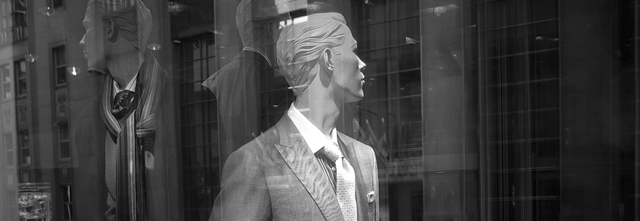As men have spiffed up their wardrobes in order to be taken more seriously in the workplace, retailers and manufacturers have responded by adopting creative methods to reach this re-discovered retail force.
Despite the still sluggish economy, total U.S. men’s apparel sales increased 4 percent to $55.71 billion in 2011, up from $53.48 billion in 2010, according to the NPD Group. On average, men’s apparel sees a 2% to 3% annual growth while women’s 3% to 4%, according to the NPD’s chief industry analyst Marshal Cohen.
The long-held belief has been that men do not like clothes shopping. But the fact of the matter is 33% of males ages 13-to-34 “love or enjoy” shopping, according to the Cotton Incorporated Lifestyle MonitorTM Survey. Of men ages 56-to-70, 16% feel the same way. Meanwhile, 27% of men overall say they “don’t mind” shopping, while most (38%) say if they need something, “I go in, get it and leave.” Only 6% of men say they do not like to shop and avoid it.
Ironically, Cohen cites the lackluster economy as a reason why men are investing more in their wardrobes.
“Men are in the need/replenishment cycle, as well as a ‘dress-for-success’ mindset,” Cohen says. “Younger and the more ‘experienced’ men are buying apparel to replenish their worn-out items and, perhaps more importantly, buying wardrobe items that will separate them from the competition in the workplace.”
The NPD reports sales of men’s tailored clothing rose 22%, while men’s dress shirt sales rose more than 14%, according to NPD data. Men were responsible for 47% of spending within apparel and accessories category in the third quarter, up from 46% in 2010 and 42% in 2009, according to American Express Business Insights.
Monitor data reveal men spend an average of $50 on apparel each month. Those age 25-to-34 and men earning $75,000 or more spend significantly more — $60 and $64, respectively.
The National Retail Federation’s Dan Butler, vice-president of retail operations, says men also shop more in the fourth quarter. “Women make up 62% of the shopping during the rest of the year, but men get out in December. And when they buy for themselves they know what they want, buy it, and they’re done.”
[quote] Men are also feeling optimistic, and this may translate to sales at the register. Nearly half (49%) are “very” or “somewhat optimistic” about their personal financial situation, the Monitor survey finds, a percentage that rises to 57% among 25-to-34 year olds, and 59% among those earning $75,000 or more.
Good prices have always been a big factor in men’s purchasing decisions. But more recently, fit (95%), comfort (94%) and quality (91%) outrank cost (90%). Those age 56-to-70 are significantly more likely than younger men (ages 13-55) to say performance features (78% versus 67%), “Made in the USA” (73% versus 53%), and laundering instructions (69% versus 54%) are important to their apparel purchases.
To keep men’s interest piqued and their wardrobes fresh, everyone from new brands to national retailers have begun staging high-flying events. Lord & Taylor held its Guys’ Night Out! bash in New York City, with a live ESPN broadcast, a book signing with NY Giant Justin Tuck, and shopping help from the NY Jets Flight Crew cheerleaders. Meanwhile, the 611 label staged a three-day pop-up shopping event in its hometown of Philadelphia, replete with art, photography, DJs and cocktails.
New men’s wear label Ankar Sweden, which was launched for spring/summer 2012, has events planned for the new year, says designer Niklas Ankar. The goal: getting men to move beyond what they already have in their closets.
“By showing the possibility of adding color and patterns to your outfit, men can see how they can completely change their appearance,” Ankar says. “Product placement, editorial and interviews are great ways to reach out and educate men on how they can mix and match without looking like a clown. But we will also be hosting events, dinners, cocktail parties and pop up shops to market the collection.”
Another trend men have latched onto is online shopping, and e-tailers have reaped the benefits. On average, men shop online about once each month, and spend an hour and a half doing so, according to the Monitor survey.
Gilt Groupe introduced men’s flash sales in 2009, and the division jumped to more than $100 million in sales by last year. The flash sales were so strong that the company introduced Park & Bond, a full-price online men’s store last summer.
Gilt works hard to draw and retain its male traffic with the Gilt MANual, an online magazine, as well as with the fashion and lifestyle pieces found in The Intersection on the Park & Bond site.
Generally, almost two-thirds of men (65%) say they get their apparel ideas from what they already own and like, followed by store displays/window shopping (35%), people they see regularly (31%) family members (25%), commercials or ads (22%), and magazines (10%), according to Monitor stats. Younger men age 13-to-34 also get a fair amount of direction from TV shows (20%), fashion magazines (13%) and celebrities (13%).
Ankar says all of these influences make men more comfortable with fashion.
“In a sense, the way you dress can reflect your character, or even help you become the character you want to be.”
